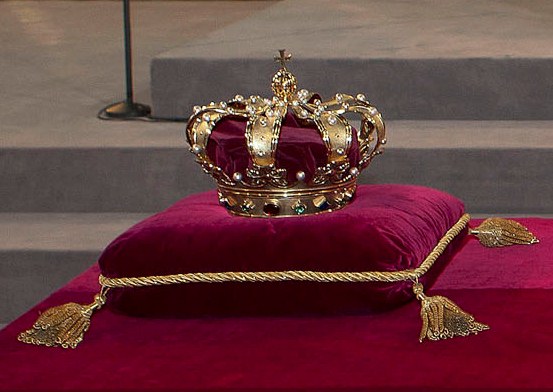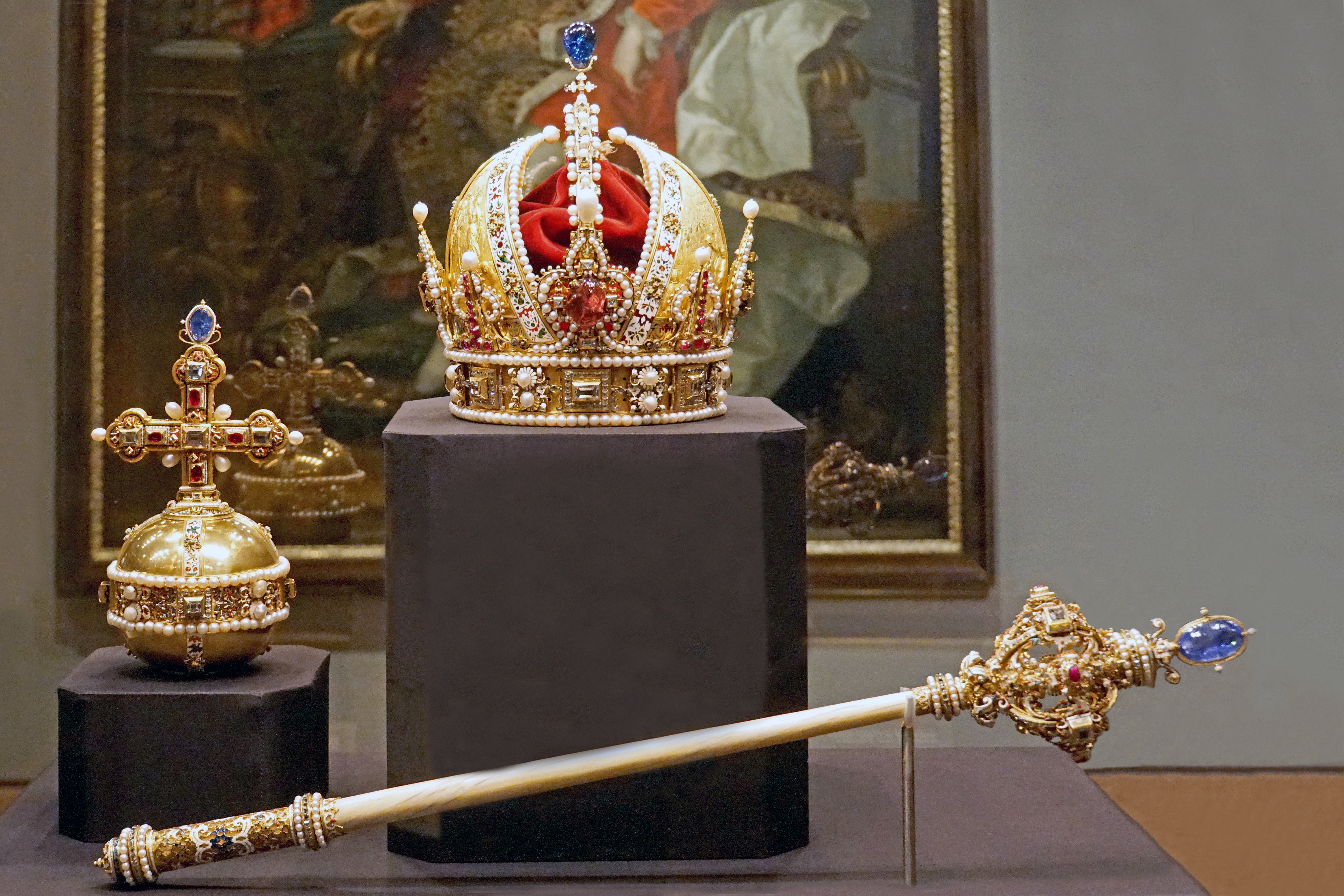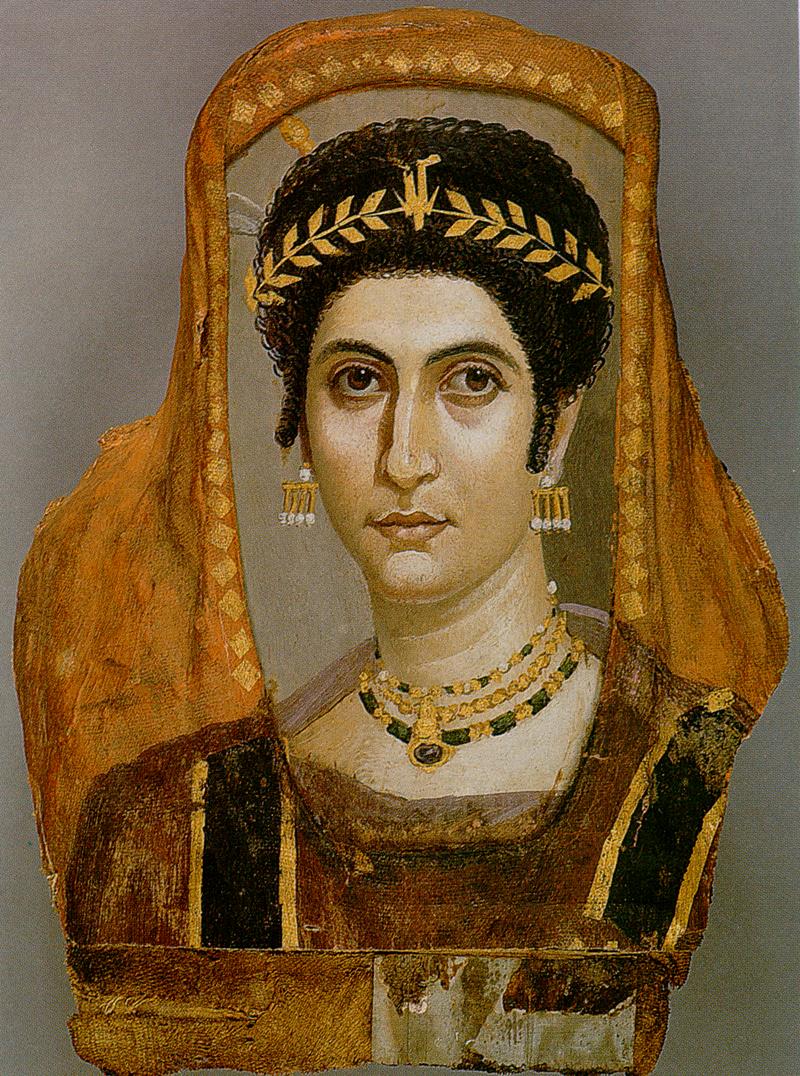|
Crown Of The Netherlands
The Crown of the Netherlands is of relatively modern origin. In 1813 the new "Sovereign Prince" of the Netherlands, Prince William I of the Netherlands, William Frederick, son and heir of the exiled stadtholder William V of Orange, Willem V of Orange, was sworn in as Dutch monarch in Amsterdam. There was no crown present at the ceremony. When, in 1815, Willem was proclaimed "King of the Netherlands" in Brussels as William I, he was not crowned but there was a crown present during his Inauguration of the Dutch monarch, inauguration, a huge and unusable construction of gilded copper, pearls made of pasted fishskin and coloured glass. The four holes in the ring, the peculiar size and the lack of a bill in the accounts that do contain the jeweler's bill for the gilded silver orb and sceptre, suggest that it was the old "funeral crown", used by the stadtholders in the 18th century and then tied to a cushion on top of the coffin when driven to the vault in Delft. This crown still exists. ... [...More Info...] [...Related Items...] OR: [Wikipedia] [Google] [Baidu] |
Kroon Van Nederland
Kroon is a Dutch, Danish, Norwegian, and Swedish language, Swedish surname, from the Swedish "''Kron''" meaning crown. It may refer to: * Estonian kroon, the former currency of Estonia * Hollands Kroon, a municipality in the Netherlands People with the surname * Ciro Kroon (1916–2001), Netherlands Antilles politician and Prime Minister * Evert Kroon (1946–2018), Dutch water polo goalkeeper * Heleen van Royen, Helena Margaretha Kroon (born 1965), Dutch novelist and columnist * Henk van der Kroon (born 1942), Dutch founder of the Federation of European Carnival Cities * Karsten Kroon (born 1976), Dutch road bicycle racer * Knut Kroon (1906–1975), Swedish football player * Larry Kroon, American evangelical pastor * Luuk Kroon (1942–2012), Dutch naval officer and Chief of the Netherlands Defence Staff * Marc Kroon (born 1973), American baseball pitcher * Marco Kroon (born 1970), Dutch soldier and recipient of the Military William Order * Niclas Kroon (born 1966), Swedish ten ... [...More Info...] [...Related Items...] OR: [Wikipedia] [Google] [Baidu] |
Wilhelmina Of The Netherlands
Wilhelmina (; Wilhelmina Helena Pauline Maria; 31 August 1880 – 28 November 1962) was List of monarchs of the Netherlands, Queen of the Netherlands from 1890 until her abdication in 1948. She reigned for nearly 58 years, making her the longest-reigning monarch in Dutch history, as well as the List of longest-reigning monarchs, longest-reigning female monarch outside the United Kingdom. Her reign saw World War I, the Great Depression in the Netherlands, Dutch economic crisis of 1933 and World War II. The only surviving child of King William III of the Netherlands and Emma of Waldeck and Pyrmont, Wilhelmina ascended the throne at the age of 10 after her father's death in 1890, under her mother's regent, regency. After taking charge of government, Wilhelmina became generally popular for maintaining Dutch neutrality during the First World War and solving many of her country's industrial problems. By that time, her business ventures had made her the world's first female billionaire a ... [...More Info...] [...Related Items...] OR: [Wikipedia] [Google] [Baidu] |
Monarchy Of The Netherlands
The monarchy of the Netherlands is governed by the country's charter and constitution, roughly a third of which explains the mechanics of succession, accession, and abdication; the roles and duties of the monarch; the formalities of communication between the States General of the Netherlands; and the monarch's role in creating laws. The monarch is head of state and ''de jure'' head of government of the Netherlands. The once-sovereign provinces of the Spanish Netherlands were intermittently ruled by members of the House of Orange-Nassau from 1559, when Philip II of Spain appointed William the Silent (William of Orange) as a stadtholder, until 1795, when the last stadtholder, William V, Prince of Orange, fled the country. William the Silent became the leader of the Dutch Revolt and of the independent Dutch Republic. Some of his descendants were later appointed as stadtholders by the provinces and, in 1747, the role of stadtholder became a hereditary position in all provinces o ... [...More Info...] [...Related Items...] OR: [Wikipedia] [Google] [Baidu] |
Individual Crowns
An individual is one that exists as a distinct entity. Individuality (or self-hood) is the state or quality of living as an individual; particularly (in the case of humans) as a person unique from other people and possessing one's own Maslow's hierarchy of needs, needs or goals, rights and moral responsibility, responsibilities. The concept of an individual features in many fields, including biology, law, and philosophy. Every individual contributes significantly to the growth of a civilization. Society is a multifaceted concept that is shaped and influenced by a wide range of different things, including human behaviors, attitudes, and ideas. The culture, morals, and beliefs of others as well as the general direction and trajectory of the society can all be influenced and shaped by an individual's activities. Etymology From the 15th century and earlier (and also today within the fields of statistics and metaphysics) ''individual'' meant "divisible, indivisible", typically des ... [...More Info...] [...Related Items...] OR: [Wikipedia] [Google] [Baidu] |
1840 Works
__NOTOC__ Year 184 ( CLXXXIV) was a leap year starting on Wednesday of the Julian calendar. At the time, it was known as the Year of the Consulship of Eggius and Aelianus (or, less frequently, year 937 ''Ab urbe condita''). The denomination 184 for this year has been used since the early medieval period, when the Anno Domini calendar era became the prevalent method in Europe for naming years. Events By place China * The Yellow Turban Rebellion and Liang Province Rebellion break out in China. * The Disasters of the Partisan Prohibitions ends. * Zhang Jue leads the peasant revolt against Emperor Ling of Han of the Eastern Han dynasty. Heading for the capital of Luoyang, his massive and undisciplined army (360,000 men), burns and destroys government offices and outposts. * June – Ling of Han places his brother-in-law, He Jin, in command of the imperial army and sends them to attack the Yellow Turban rebels. * Winter – Zhang Jue dies of illness while his broth ... [...More Info...] [...Related Items...] OR: [Wikipedia] [Google] [Baidu] |
Crown Jewels
Crown jewels are the objects of metalwork and jewellery in the regalia of a current or former monarchy. They are often used for the coronation of a monarch and a few other ceremonial occasions. A monarch may often be shown wearing them in portraits, as they symbolize the power and continuity of the monarchy. Additions to them may be made, but, since medieval times, the existing items have been typically passed down unchanged, symbolizing the continuity of a monarchy. Typical items in Europe include Crown (headgear), crowns, sceptres, globus cruciger, orbs, swords, ceremonial maces, and jewelry ring, rings, all usually in gold or silver-gilt and heavily decorated with precious and semi-precious gemstones, in styles which go back to the Middle Ages and are normally very conservative to emphasize the continuity of the monarchy. Many working collections of crown jewels are kept in vaults or strongrooms when not in use and can be seen by the public. The crown jewels of many former mon ... [...More Info...] [...Related Items...] OR: [Wikipedia] [Google] [Baidu] |
Papal Tiara
The papal tiara is a crown that was worn by popes of the Catholic Church from as early as the 8th century to the mid–20th century. It was last used by Pope Paul VI in 1963, and only at the beginning of his reign. The name ''tiara'' refers to the entire headpiece, including the various crowns, circlets, and diadems that have adorned it through the ages, while the three-tiered form that it took in the 14th century is also called the triregnum or the triple crown, and sometimes as the triple tiara. From 1143 to 1963, the papal tiara was solemnly placed on the pope's head during a papal coronation. The surviving papal tiaras are all in the triple form, the oldest from 1572. A representation of the triregnum combined with two crossed keys of Saint Peter is used as a symbol of the papacy and appears on papal documents, buildings and insignia, and on the flag of Vatican City. Actual use of the papal tiara has declined since the reign of Pope Paul VI, the last pope to have a corona ... [...More Info...] [...Related Items...] OR: [Wikipedia] [Google] [Baidu] |
Tiara
A tiara (, ) is a head ornament adorned with jewels. Its origins date back to ancient Greco-Roman world. In the late 18th century, the tiara came into fashion in Europe as a prestigious piece of jewelry to be worn by women at formal occasions. The basic shape of the modern tiara is a semicircle, usually made of silver, gold, or platinum and richly decorated with precious stones, pearls, or cameos. Tiaras were extremely popular during the late 19th century and were worn at events where the dress code was white tie. After World War I, wearing a tiara gradually fell out of fashion, except for official occasions at a royal court. Interest in tiaras has increased again since the beginning of the 21st century. The word ''tiara'' is often used interchangeably with the word ''diadem''. Description The basic shape of the modern tiara is a semi-circle, usually made of silver, gold or platinum. Tiaras have also been made from tortoiseshell, coral and quartz, and in the 20th century ... [...More Info...] [...Related Items...] OR: [Wikipedia] [Google] [Baidu] |
Helmet
A helmet is a form of protective gear worn to protect the head. More specifically, a helmet complements the skull in protecting the human brain. Ceremonial or symbolic helmets (e.g., a policeman's helmet in the United Kingdom) without protective function are sometimes worn. Soldiers wear combat helmets, often made from Kevlar or other lightweight synthetic fibers. The word ''helmet'' is derived from ''helm'', an Old English word for a protective head covering. Helmets are used for most sports (e.g., jockeys, American football, ice hockey, cricket, baseball, skiing, hurling and rock climbing); dangerous work activities such as construction, mining, riot police, military aviation, and in transportation (e.g. motorcycle helmets and bicycle helmets). Since the 1990s, most helmets are made from resin or plastic, which may be reinforced with fibers such as aramids. Designs Some British gamekeepers during the 18th and 19th centuries wore helmets made of straw bound together wi ... [...More Info...] [...Related Items...] OR: [Wikipedia] [Google] [Baidu] |
Diadem (personal Wear)
A diadem is a crown, specifically an ornamental headband worn by monarchs and others as a badge of royalty. Overview The word derives from the Greek διάδημα ''diádēma'', "band" or "fillet", from διαδέω ''diadéō'', "I bind round", or "I fasten". The term originally referred to the embroidered white silk ribbon, ending in a knot and two fringed strips often draped over the shoulders, that surrounded the head of the king to denote his authority. Such ribbons were also used to crown victorious athletes in important sports games in antiquity. It was later applied to a metal crown, generally in a circular or "fillet" shape. For example, the crown worn by Queen Juliana of the Netherlands was a diadem, as was that of a baron later (in some countries surmounted by three globes). The ancient Celts were believed to have used a thin, semioval gold plate called a ''mind'' (Old Irish) as a diadem. Some of the earliest examples of these types of crowns can be found in anc ... [...More Info...] [...Related Items...] OR: [Wikipedia] [Google] [Baidu] |
Coronet
In British heraldry, a coronet is a type of crown that is a mark of rank of non-reigning members of the royal family and peers. In other languages, this distinction is not made, and usually the same word for ''crown'' is used irrespective of rank (, , , , , etc.) In this use, the English ''coronet'' is a purely technical term for all heraldic images of crowns not used by a sovereign. A Coronet is another type of crown, but is reserved for the nobility - Dukes, Marquesses, Earls, Viscounts and Barons. The specific design and attributes of the crown or coronet signifies the hierarchy and ranking of its owner. Certain physical coronets are worn by the British peerage on rare ceremonial occasions, such as the coronation of the monarch. These are also sometimes depicted in heraldry, and called coronets of rank in heraldic usage. Their shape varies depending on the wearer's rank in the peerage, according to models laid down in the 16th century. Similar depictions of crowns of rank () ... [...More Info...] [...Related Items...] OR: [Wikipedia] [Google] [Baidu] |







